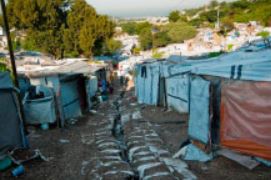


After first restating the main issues that arise in precarious and informal habitat or shanty town areas, restating the difficulties faced and especially the technical, social, legal or governance means that can facilitate access to water by the residents of these areas.
For the technical means available for carrying water to shanty towns, please refer to Factsheet E 49 b as regards distributing the water to Factsheet 49 c and for those relating to governance and management modes, to Factsheet E 49d.
For issues that are specific to sanitation, please refer to Factsheets A15 and A16.
Their definitions vary by author and by country. The most often used definitions are as follows :
- An informal habitat area, sometimes also referred to as “spontaneous neighbourhood” areas are dense collections of sordid buildings or shanties put up without any official sanction on public or private land, generally located around cities. In these areas “water rights” come into conflict with “property rights”.
- A precarious habitat is one of temporary buildings, generally squalid and resembling a shanty, but not necessarily located in an informal habitat area so this habitat may be perfectly legal.
- A shanty town is a densely built-up, run-down and most often unofficially sanctioned area (but not necessarily so, as some that have been in place for a long time in the most impoverished parts of towns may have finally gained recognition from some authorities, even if they are unofficial, and therefore have gained official tolerance).
For UN-Habitat, a shanty town is a place where the run-down substandard accommodation does not ensure their occupants proper protection against bad weather conditions, does not offer enough space (with more than three people per room), away from a point of access to water at affordable cost and without even toilets close by and offering no tenure security to protect inhabitants from expulsion. Such areas are for the most part squalid, self-built shacks, erected in a hurry and without official permission, in close proximity of each other and on land that is unsuitable (areas prone to flooding, swamps, in valleys, on unstable hillsides, etc.) hard to access and lacking in public services.
Furthermore, all of the previously mentioned kinds of habitat may be encountered in a single city or neighbourhood for the technical, social and economic conditions of neighbouring locations may vary considerably and this does not make it any easier to find solutions to these problems. They cover differing realities as they range from squalid informal and unrecognised suburban areas to very poor ones with high population densities right in the centre of town.
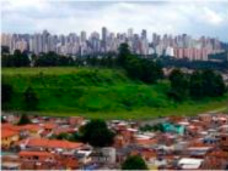
Cities often grow quickly, both upwards and outwards, but the problems faced differ considerably depending on whether one is in a built up area that was planned and has received official sanction and one without any urban development plan.
Lastly, two categories of informal precarious habitats are often identified :
- Groups of precarious habitats that built up spontaneously and most often without any property or tenancy rights, and
- Already well established shanties, generally run-down, but where the status of occupants has come to be recognised and legally accepted by the authorities often with the hope of going on to build new neighbourhoods, as part of urban development plans, covering what are sometimes called “slum areas” that are often a little less badly treated by the authorities.
A number of studies conducted in Africa have however shown that most of these kinds of habitat present certain shared characteristics such as :
- A crucial lack of access to drinking water in sufficient quantity and quality,
- A significant decrease in the number of public standpipes and the facilities for their use,
- Low water consumption by inhabitants, often limited to 5 to 30 litres of water per day, for the most part bought from small scale sellers or neighbours and paid for on a daily basis rather than by a monthly bill or contribution,
- The price of water in shanty towns that is significantly higher than that of water from the public network,
- A preference by families for getting their supplies of water from different sources depending on the day, their own resources, the season or distance (standpipes, water kiosks, private wells or drillings fitted with pumps, etc.),
- The emergence of a certain “capacity and willingness to pay” on the part of a number of families or neighbourhoods who seeing the high cost of their purchases from water resellers are ready to invest, on soft terms, in the creation of new installations or private hook-ups.
All of this highlights the fact that before envisaging doing anything in such an area, it is essential to first conduct an in-depth survey of its characteristics, whether technical, economic or socio-cultural, as well as determining the true needs and expectations of the population and their local leaders for it must never be forgotten that they are the most able to do this and to become the best players in their own development.
For greater ease of understanding, in this Factsheet we will use the common term of “shanty towns” to designate each of these kinds of habitat.
In developing nations, a considerable share of the urban population (over 950 million people, or almost one third of the world’s urban population according to UN Habitat), in this the century of smartphones and tablet computers, in squalid neighbourhoods with only very limited access to basic services. Most of the time, the provision of drinking water and sanitation for these neighbourhoods is inadequate or even almost non-existent, or costs far too much for the poor populations who live there.
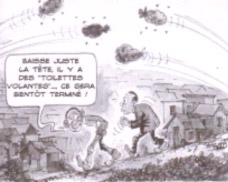
Paradox : The poorest inhabitants pay the most for their water as they cannot connect to public networks, they have to pay high prices (often two or three times more, but sometimes as much as 30 times more than the public price) to small time private resellers.
Consequently, in the shanty towns of New Delhi, the price is 4.9 times higher, 5 to 6 times higher in Ouagadougou (Burkina Faso) and Port au Prince (Haiti) and as much as 20 to 25 times higher in Lima and Djakarta…
The sanitation situation is unfortunately even worse than that of water and leads to many illnesses as well as making life easy for epidemics. One of Africa’s largest shanty towns, that of Kibera (in Nairobi) has even been nicknames the “flying toilets” shanty town as many inhabitants throw their excrement out of the windows in plastic bags for lack of toilets…
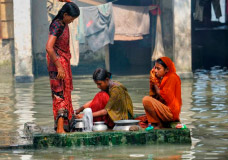
These issues are aggravated by the often uncontrolled and rapid population growth and urban sprawl found in developing nations.
The world’s urban population is currently rising by more than ten million people every year.
Although happily, according to the United Nations, 227 million people were able to leave shanty towns during the last 12 years, the number of people still living in them rises by some 10% every year and may well, according to UN Habitat, hit three billion by 2050. In the same way, if nothing is done, and if no new and innovative territorial development policy is embarked on to slow the rural exodus, the fear is that half of the 300 million Africans living in African urban areas will by 2020, live in shanty towns…
We further observe that more and more earthquake or flood related disasters hit shanty town dwellers first and foremost.
Yet, major city authorities and the major water utilities that they sometimes contract out water production and distribution to are unable to meet rising demand and are left helpless in the face of disaster and especially, in many cases, do not have the political or social willingness to truly take on this crisis situation.
So, what is to be done ?
What part can the population play in such situations and how can they organise themselves to meet such challenges ?
What often happens in practice, for lack of a better solution, is that many small private or even informal operators, who are in practice unavoidable, resell the water that is essential to individuals, at prices often far higher than that of the water provided by a connection to the municipal supply. How can we avoid this paradox where water actually costs poor populations far more than richer ones ?
This is the purpose of this Factsheet and the various envisageable solutions or lines of thought.
It should however be stated right away, that if access to water in precarious neighbourhoods and shanty towns calls for finding technical and financial solutions that make allowance for their social and cultural specificities, the true solution to these problems is not a technical or financial one, for most often the need is to respond to a shortage of water resources or administrative, technical or financial obstacles that cannot be avoided but that are truly political in nature. The current situation is essentially :
- Caused by lack of political will on the part of the local, regional or national authorities who abandon these issues in favour of other simpler or more prestigious activities, and
- Sometimes also, due to a lack of enthusiasm on the part of local water utilities who prefer to invest in areas that are more solvent or profitable or that hesitate to invest without permission or financial support from the authorities that have entrusted them with managing the service.
Building or extending a water network, or a sewage network for that matter, in poor areas where the population is also growing very rapidly and were frequent extension are required, is often no easy task.
- First of all, there are often serious technical difficulties or constraints dues to topographical aspects and to the geographical characteristics of the areas, with a lack of roads, an imbroglio of alleyways and homes, winding narrow passages, limited public space that is accessible for laying pipes, severe slopes or gradients, as in the hillside “favelas” of Rio de Janeiro or in Port au Prince or simply because of very high density housing.
- Furthermore, these areas are often considered as illegal by the authorities. As the inhabitants have no land titles, governments or municipalities most often do not wish to see :
- The water or electricity supply seen as a more or less tacit recognition of any right to live there,
- Any recognition of rights granted these inhabitants, and this despite the recent enactment by the United Nations General Assembly in 2011 of a right to water, as a public service, for fear especially of attracting even more people and not being able to make them leave again, e.g. when undertaking a real estate restructuring or construction project.
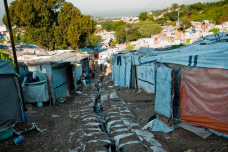
For their part, the private utilities that manage the service do not wish to, or cannot, afford conflictual relations with the municipal authorities in charge and further fear the destruction of any infrastructures that they may build in the event of any expropriation that may take place.
They therefore generally consider as especially risky, any investments made in poor areas that are unofficial, anarchic and unplanned and especially in shanty towns, all the more so if the municipality does not wish to make any financial effort of their own. Additionally, as the price of water needs to be adapted to suit the income of the inhabitants, utilities prefer to invest in better off neighbourhoods, thereby guaranteeing that their investment will pay off better and be less risky in terms of bill collection.
Those utilities that nevertheless do bring water to these areas most often concentrate their efforts on creating public standpipes to provide supplies for a fee or for free or water kiosks but they also make as many private connections as possible for greater comfort but also to balance their books and make money from the operation. The cost of these connections is a high one and may represent the equivalent of many month’s income. Unfortunately, the poorest families do not have the financial means to bear this cost which remains an unaffordable one for them.
We do however note that major utilities have recently, often with World Bank aid, started to add specific plans for lower cost “social” connections to their programs, combined with soft credit terms or long term spreading of connection costs, as is the case in Morocco or Algeria.
We have briefly seen the various ways to do this. There are many, but there is no ideal solution, especially as the solution is often seriously dependent on the specific technical, but also socio-economic condition of the shanty towns and this sometimes varies across neighbourhoods, depending on their social cohesion and financial means.
It is therefore fundamental, before designing or proposing any program to talk to :
- The people in charge of these neighbourhoods or their leaders, who are sometimes completely dedicated to improving them but also sometimes out to make a name for themselves or have political views in mind,
- And also, local or city authorities so as to determine their position, their means, their projects and what possibilities there are for collaboration, but also to prompt them to act.
It is also necessary to not set targets that are too low or too ambitious, to consider that the situation is only a temporary one, but rather to take a medium or more or less long term view by already implementing more sophisticated installations, especially where a true desire for significant improvement has been observed on the part of certain residents or neighbourhoods and a certain “ability to pay”.
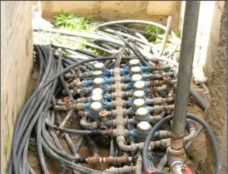
Contrary to the oft stated idea, there are not just people living in poverty in shanty towns, even if many are. This is because many work there, more work outside of them, and in some parts there is a certain “ability to pay” (otherwise, how could they pay for the high price services offered by small scale water carriers or distributors ?). Some residents are therefore willing to pay for a better quality service, one that will in time let them make savings.
This, for example, is the case for those who wish to be able to obtain a private connection (especially when municipal authorities or utilities organise campaigns to install “social connections” under attractive financial conditions as detailed in Factsheet E47), so that they can get access to water that is often of better quality, better supervised and at a far lower price, all without waiting.
Such initiatives will later on help to pull other population categories or other neighbourhoods upwards when, later on, they two have the necessary means.
Lastly, we should restate that it is really essential to ensure that local authorities take an interest in this issue, do not underestimate the advantages and the importance of community based management modes, nor the role played by small private operators who create jobs and boost the local economy. The authorities should also understand that they could doubtless better manage or organise these aspects and that they should include shanty towns and all precarious habitat areas into their urban development plans, if only to stop them from expanding further.
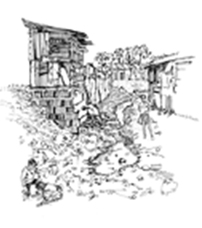
- Partenariat Eau et Assainissement en Afrique : “Améliorer l’accès des populations urbaines démunies aux services d’eau et d’assainissement” (Improving access by impoverished urban populations to water and sanitation services). A collection of best practices in Sub-Saharan Africa. Articles on standpipes, private connections, small scale private water resellers, 2004. Available from : http://www.pseau.org/outils/ouvrage...
- PSEau : (A. Morel and A. L’huissier) : A well documented 180 page report that is mainly aimed at those who wish to undertake or improve programmes of this kind : “Analyze des paramètres économiques de la distribution d’eau pour les populations à faibles revenus des quartiers périurbains et des petits centres de 10 pays africains” (An analysis of economic parameters in water distribution for low income populations of suburban neighbourhoods and small population centres in ten African nations) (Tools for assessing population demands, various kinds of charges and costs, software to assist with cost management…). Available online from :
http://www.pseau.org/outils/ouvrages/eau_potable_assain_periurbains_1999_VF.pdf</SPAN>
- COLLIGNON B.& VEZINA M. : “Independent Water and Sanitation Providers in African Cities”) (Water and Sanitation Program - World Bank, Washington, 2000). A 90 page report on ten case studies covering water and sanitation resale businesses. Available from : http://www.pseau.org/outils/biblio/...
- PSEau : “Eau potable et assainissement dans les quartiers périurbains et les petits Centres” (see above), a summary from a workshop on the conclusions of a study run
on this subject in 15 countries by GRET and various bodies. WEDC charcoal drawing
http://www.pseau.org/outils/ouvrages/pseau_epaqppc_act_rech_3_rap_fi.pdf</SPAN>
- IRD : A 14 page report by Emile Le Bris “L’accès à l’eau potable dans les quartiers défavorisés des grandes villes et les petits centres urbains” (Access to drinking water in poor parts of major cities & small urban centres)
http://horizon.documentation.ird.fr...